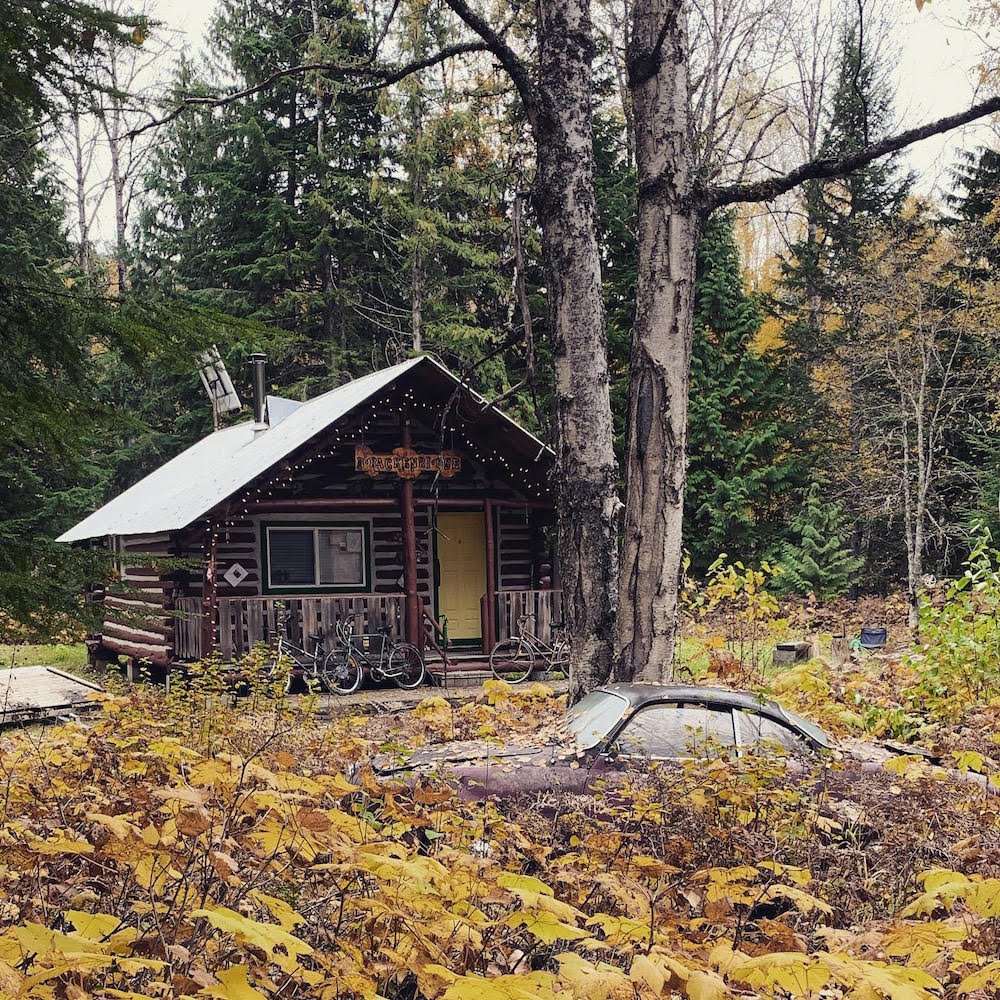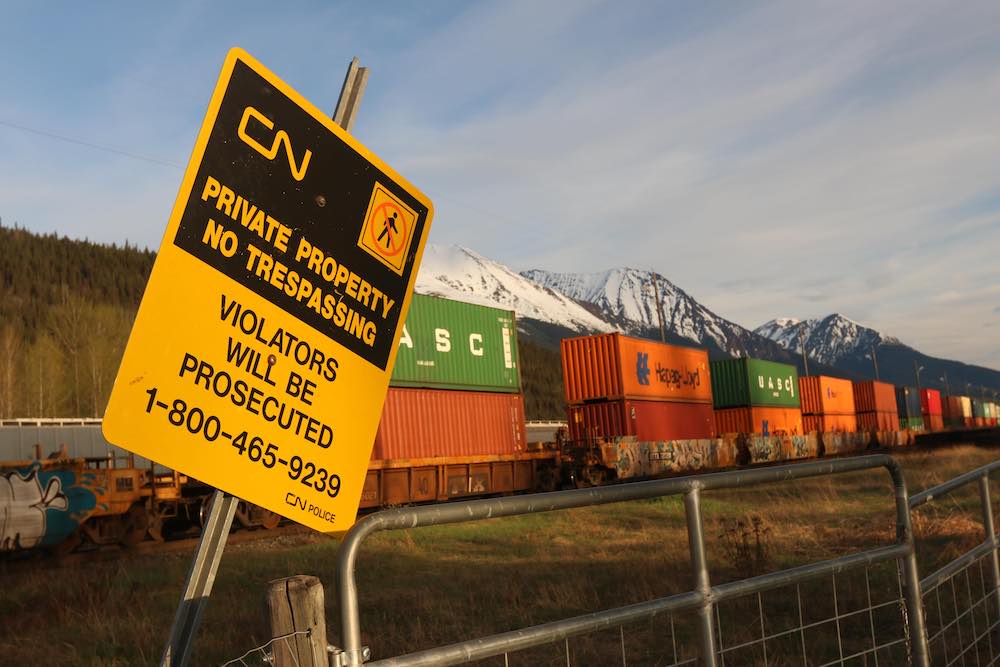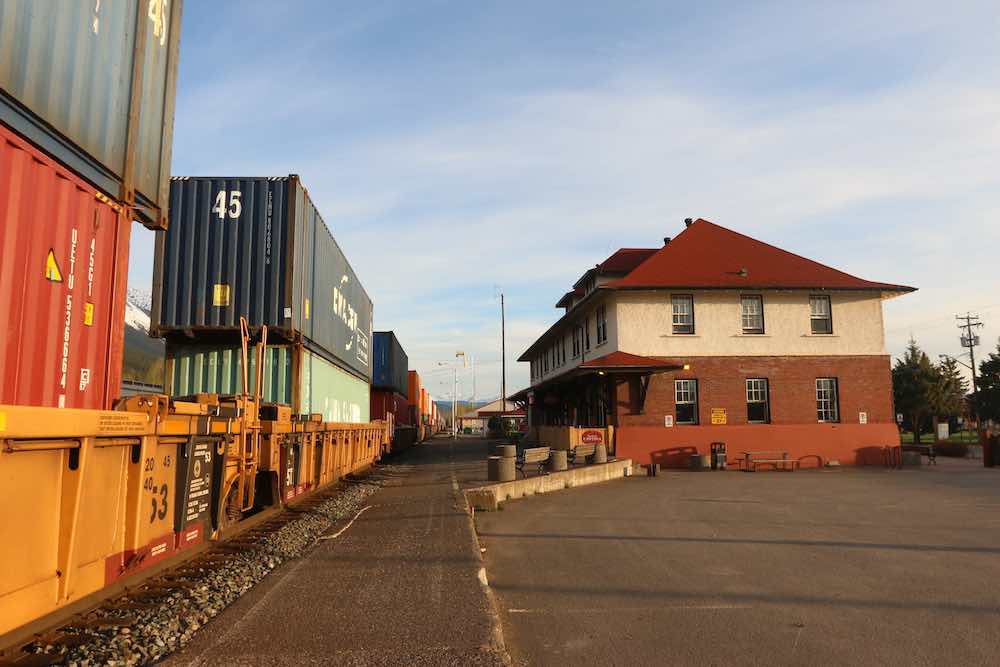It’s been nearly four months since a passenger train rolled through northern B.C., despite its status as an essential service.
That’s disrupted a critical transportation service, made life more dangerous for some northerners and left some communities — like the tiny town of Dorreen — largely disconnected from the outside world.
In early March, almost a month after the service was halted, the town’s only full-time resident decided it was time to head home from Terrace where he had been staying.
With no rail service, he caught a long snowmobile ride home.
But as the passenger rail service shutdown continued, friends began to worry about his safety alone in Dorreen. There’s no cell service and the train is normally a lifeline.
“He wasn’t expecting to be out there that long. That’s a long, long time,” said Jane Stevenson, who owns a cabin in the community but lives in Smithers. With no train service, Stevenson wasn’t able to access her cabin — and check on her neighbour — until the May long weekend when she drove in over snow and a recent landslide on an unmaintained logging road.
She found her neighbour in good health. The man, in his 50s, told her that after eight weeks alone in the town he had boated across the Skeena River and hitchhiked to Terrace for supplies before making his way back to Dorreen. He had since returned. (Stevenson didn’t want to name him for this report without his consent, and couldn’t reach him.)
“He took quite a few significant risks — boating at high water, hitchhiking on the Highway of Tears during COVID. If only VIA was there to pick him up,” she said. “If VIA had been there, he wouldn’t have needed to take that risk. He needed his supplies.”
Rail lines opened up much of northern B.C. to settlers, with communities scattered along what was then the Grand Trunk Pacific Railway. Some now rely on VIA Rail service for connection to the outside world.
The service has become increasingly slow and unreliable as heavy freight traffic to the Port of Prince Rupert has sidelined the region’s passenger trains.
But in early February, the Jasper-Prince Rupert passenger service was shut down entirely. People living in the area want to know why the “essential” service was eliminated and who made the decision.
The initial shutdown was linked to the Wet’suwet’en standoff. On Feb. 8, supporters of hereditary chiefs opposing the Coastal GasLink pipeline blocked the railway at Hazelton, 90 kilometres east of Dorreen, shutting down all traffic.
VIA Rail had notified passengers the day before that it was cancelling service “due to operational issues” and that no alternate transportation would be provided for people who had already booked seats.
Barricades remained on the tracks for six days before they were taken down voluntarily when it appeared government officials would meet with First Nations hereditary chiefs. They went back up for two days on Feb. 23 until the RCMP acted upon an injunction obtained by CN Rail and arrested 14 people in Hazelton.
Freight trains along the tracks were halted for a total of eight days. Three-and-a-half months later, passenger train service hasn’t resumed.
Stevenson says she was about to go to Dorreen with her parents, who also have a cabin there, to celebrate her birthday when the service was cancelled.
“If we had gone out there in that brief window of time, we would still be out there,” Stevenson says. “The protestors were an inconvenience, a legitimate shutdown. The COVID, obviously you have to be very cautious with human life and worker safety. But now what’s the excuse?”
In an April 6 news release, VIA blamed travel restrictions, physical distancing and “continued infrastructure issues” for the extended service suspension. At that time, it gave June 1 as a reopening date.
But the biggest reason appears to be CN. The country’s largest railway company owns 83 per cent of the tracks VIA runs on. In an email to The Tyee earlier this month, VIA said that CN was partly to blame for the shutdown.
“The infrastructure owner [CN Rail] asked us to suspend our return to service following the blockades to allow them to reduce the congestion on that line, and to also invest in some infrastructure improvements aiming to improve capacity,” public relations advisor Karl-Philip Marchand Giguere said. “The suspensions due to COVID-19 then came along before we could provide a resumption timeline.”
CN has made it clear it won’t tolerate disruptions to its own operations.
Two days into the February blockades, as freight sat on the tracks and dozens of container ships waited offshore, CN applied for an injunction in the B.C. Supreme Court to remove blockades.
At the same time, it filed a civil claim against “John Doe, Jane Doe and persons unknown” for obstructing trains on its BC North Line and trespassing on CN property seeking unspecified damages. The claim notes that an average $135 million in freight moves daily between the Alberta border and Port of Prince Rupert.
Revenue from moving that freight is significantly less. According to CN’s latest quarterly report, the company had revenues of $3.5 billion in the first quarter of this year — $38 million per day. Describing the network as “fluid,” CN president and chief executive officer J.J. Ruest said the company “recovered quickly” from February’s service disruptions.
Terry Johnson, president of Transport Action Canada, said the disruptions can’t be blamed for the prolonged shutdown of VIA passenger service. It might have taken CN a month to clear any freight backlog, he said. “That shouldn’t be an issue at this point,” he says.
On May 13, the advocacy group wrote Transportation Minister Marc Garneau calling on the federal government to provide emergency funding to long-distance passenger transportation services during the pandemic.
“Trains and long-distance motor coaches provide a lifeline to many communities along their routes, and even though passenger numbers are down due to travel restrictions and public health measures, these communities should not be left completely isolated,” it says.
“Although tourist revenues usually help to support the cost of providing these services, completely suspending them is not an appropriate reaction to the absence of tourism.”
Johnson said he had not received a response.

Transportation — and, specifically, “workers responsible for operating dispatching passenger, commuter and freight trains” — is included in Public Safety Canada’s list of essential pandemic services.
But passenger rail service on the northern B.C. route was designated essential long before COVID-19 — since 1990, according to VIA Rail. In its 2016-2020 corporate plan, the Crown corporation recognizes its role in servicing remote areas.
“VIA Rail operates the national passenger rail service on behalf of the Government of Canada, providing inter-city service and regional and essential remote rail transportation,” the plan says, listing the Jasper-Prince Rupert line among its regional and remote services.
“While not intended to be commercially viable, these train services operate in hard-to-reach areas where travel options are limited…. In some areas, roads were built providing access (permanent or seasonal) by car or truck and passenger trains became a complementary but essential service for a customer segment without car access or other means to transport supplies to their communities.”
Who defines essential transportation service, and how? It’s a hard question to answer.
“We’ve been trying to understand this, too,” says Johnson, who has advocated for services like northern Ontario’s Algoma line, which was purchased by CN Rail in 2001 as part of a larger network and later shut down.
Inquiries about designating an essential service were bounced between various ministries and levels of government. B.C.’s Ministry of Transportation directed The Tyee to the federal government. Canada’s Department of Justice deferred to Public Safety Canada and Transport Canada. Public Safety Canada says it does not curate a list of essential services and suggested contacting VIA or CN about the process for requesting service suspensions.
VIA Rail and CN Rail each directed questions to the other.
A representative from Transport Canada, speaking on background, described a system of co-operation between levels of government and industry that is both fluid and undefined. There is no list of essential services, the federal employee said, nor are there guidelines for suspending one.
A National Strategy for Critical Infrastructure published in 2009 by Public Safety Canada outlines a “collaborative approach” that “fosters the development of partnerships among federal, provincial and territorial governments and critical infrastructure sectors.”
“Responsibilities for critical infrastructure in Canada are shared by federal, provincial and territorial governments, local authorities and critical infrastructure owners and operators — who bear the primary responsibility for protecting their assets and services,” it says. “Individual Canadians also have a responsibility to be prepared for a disruption and to ensure that they and their families are ready to cope for at least the first 72 hours of an emergency.”

In northern B.C., the loss of essential infrastructure has continued months beyond those first 72 hours.
When pressed for details about why it asked VIA to suspend service, a CN representative said it was “to allow CN to return to normal operating levels” following the blockades.
“As the COVID-19 pandemic struck right as the company was returning to normal operations, CN took advantage of the drop in traffic to advance infrastructure and maintenance work on that corridor,” said CN senior manager of media relations Jonathan Abecassis. “While the work will improve long-term fluidity on that corridor, it temporarily impacts the available capacity while it is being performed.”
This week, VIA said that passenger service will resume along the route July 5, with one weekly round trip between Jasper and Prince Rupert. It says bookings will be limited to allow for physical distancing.
Passenger service on the route is heavily subsidized by the federal government.
The train was running three times a week and the full trip from Jasper to Prince Rupert took two days and required an overnight stay in Prince George, where travellers are responsible for their own accommodation. Fares range from $147 to $221, according to VIA’s website, but that’s only a portion of the ticket’s true cost.
According to VIA’s most recent annual report, fare revenue covered about one-sixth of the cost to operate the route in 2018, leaving a shortfall of more than $8 million. For each passenger who travels the route the government provides a $500 subsidy. In urban areas like southern Ontario, the subsidy can be as low as $23 per passenger.
In 2018, VIA received $272 million in government operating funding and $121 million in capital funding.
While the northern line remains closed, VIA continues to operate most of its services, although the long-distance trains the Canadian and the Ocean have been suspended until Nov. 1. Its Winnipeg-Churchill line, also considered an essential service, continues but without the option of travelling in a sleeper coach.
Skeena-Bulkley Valley MP Taylor Bachrach said governments may need to reconsider how VIA’s funding is allocated.
“I think the train occupies an important place in the culture of the northwest and I would like to see it remain in place for as long as possible. That’s going to require investment,” he says, noting that most of VIA’s subsidy goes toward operating costs rather than capital upgrades.
“That can only continue for so long until we see stations and rolling stock start to really show their age,” he says. “I do think that if cancelling the train altogether was put on the table there would be a strong reaction from communities in our region.”
That was the case three years ago when Greyhound, whose bus service was also considered essential to the north, applied to the BC Passenger Transportation Board to stop servicing the region.
The board held community meetings in Prince George, Terrace, Smithers and Fort St. John and received roughly 100 written comments and 1,700 form letters from northerners opposing Greyhound’s application.
In the end, Greyhound was allowed to pull out with two weeks’ notice.
The Highway 16 corridor continues to be served by BC Bus North. The line, which runs between Prince Rupert and Prince George, has been operated since 2018 by Diversified Transportation Ltd. in a cost-sharing partnership with the provincial and federal governments.
While the Passenger Transportation Board regulates services like ride hailing, taxis and inter-city buses, it does not regulate trains, chair Catherine Read says.
Johnson said when it comes to suspending rail service, it’s unclear whether CN Rail is answering to anyone.
“It does not appear to be the case that there is any oversight of this process,” he said. “If there’s a real, physical problem, such as a blockade on that line or an infrastructure issue or a derailment, yes, fine, but to suddenly suspend services where the trains could clearly get through, I’m shocked that could happen.”
CN took over the assets of B.C.-government owned BC Rail in 2004, shortly after the Port of Prince Rupert’s expansion was announced. That marked a turning point for passenger rail service in the north as freight took priority and passenger trains faced long waits on sidings to allow them to pass.
“When I first had my cabin out there in early 2000s, VIA was never bumped to the side of the tracks. Freights always moved aside for VIA. They called VIA the ‘Queen of the Rails.’ All of a sudden, VIA had to go to the side and CN had the right-of-way,” Stevenson remembers.
Today, VIA’s corporate plan depicts an uneasy relationship with its landlord.
“CN has limited incentives to allocate more capacity to passenger rail service providers like VIA Rail if such allocation has the potential to impact its operations,” the plan notes, describing an imbalance between freight railway infrastructure owners and passenger rail operators that hurts both VIA’s bottom line and the “Canada brand.”
“As noted earlier, unlike elsewhere, passenger trains in Canada do not have operational priority. CN can essentially veto or unilaterally alter any request to improve passenger travel times and frequencies,” it says.
It’s that veto power that Stevenson’s uncomfortable with.
“If CN has the power and control to shut down a Canadian essential service, that’s really inappropriate,” she says.
“Passenger rail service has been on that route since 1912 and I think it’s completely ridiculous to feel that it may go away. It cannot go away. It could be paused for legitimate reasons, like humans on the track protesting, or diseases, but once that’s passed I don’t see any legitimacy to there not being any service.” ![]()
Read more: Transportation, Coronavirus
















Tyee Commenting Guidelines
Comments that violate guidelines risk being deleted, and violations may result in a temporary or permanent user ban. Maintain the spirit of good conversation to stay in the discussion.
*Please note The Tyee is not a forum for spreading misinformation about COVID-19, denying its existence or minimizing its risk to public health.
Do:
Do not: